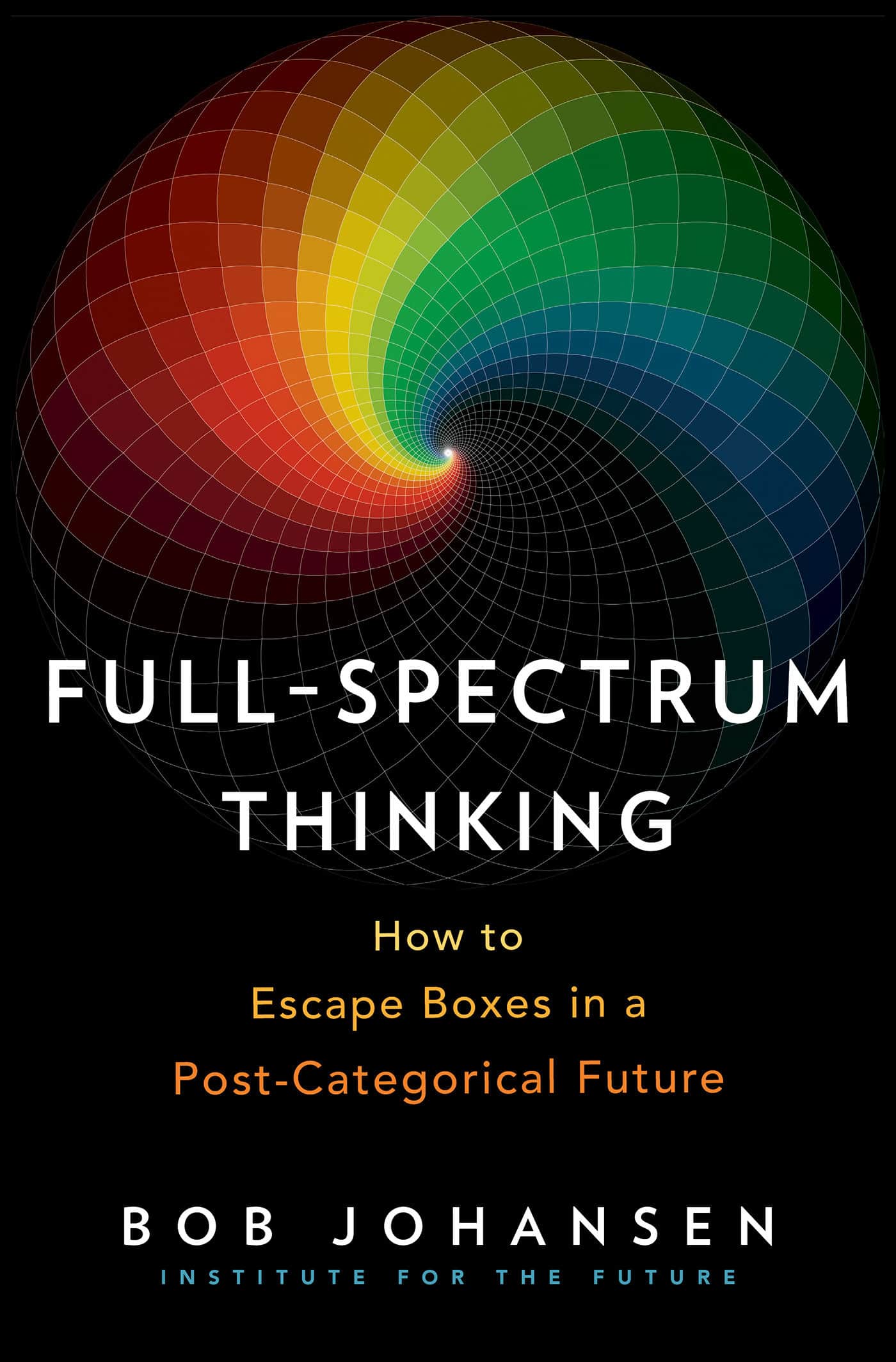Full-Spectrum Thinking: How to Escape Boxes in a Post-Categorical Future
| by |
|---|
21.00 JOD
Please allow 2 – 5 weeks for delivery of this item
Description
Leading futurist Bob Johansen shows how a new way of thinking, enhanced by new technologies, will help leaders break free of limiting labels and see new gradients of possibility in a chaotic world.The future will get even more perplexing over the next decade, and we are not ready. The dilemma is that we’re restricted by rigid categorical thinking that freezes people and organizations in neatly defined boxes that often are inaccurate or obsolete. Categories lead us toward certainty but away from clarity, and categorical thinking moves us away from understanding the bigger picture. Sticking with this old way of thinking and seeing isn’t just foolish, it’s dangerous.Full-spectrum thinking is the ability to seek patterns and clarity outside, across, beyond, or maybe even without any boxes or categories while resisting false certainty and simplistic binary choices. It reveals our commonalities that are hidden in plain view. Bob Johansen lays out the core concepts of full-spectrum thinking and reveals the role that digital media–including gameful engagement, big-data analytics, visualization, blockchain, and machine learning–will play in facilitating and enhancing it. He offers examples of broader spectrums and new applications in a wide range of areas that will become possible first, then mandatory. This visionary book provides powerful ways to make sense of new opportunities and see the world as it really is.
Additional information
| Weight | 0.51 kg |
|---|---|
| Dimensions | 1.88 × 16.67 × 24.13 cm |
| PubliCanadation City/Country | USA |
| by | |
| format | |
| Language | |
| Pages | 208 |
| publisher | |
| Year Published | 2020-3-20 |
| Imprint | |
| ISBN 10 | 152308751X |
| About The Author | Bob Johansen is a distinguished fellow at the Institute for the Future in Silicon Valley. He has done forecasts for a wide range of corporations, including Procter & Gamble, Kellogg's, Disney, Intuit, Walmart, Syngenta, GlaxoSmithKline, and United Rentals. He is the author or coauthor of twelve books, including The New Leadership Literacies, Leaders Make the Future, Get There Early, and The Reciprocity Advantage. |
“This is a great read that energizes me. Leaders must engage with humility and courage to set clear direction—but look to their teams for the best execution across a spectrum of possibilities. Right or wrong is a fallacy that must be replaced by opportunities to dynamically decide, test, and adapt.” —Jason Field, President and CEO, W. L. Gore & Associates “Full-Spectrum Thinking challenges us to be courageous as we knit together what humans do best with the power of computing for better outcomes at greater speed. We need to inspire human resources leaders to be the role models of try, fail fast and cheap—and try again as we build tools, frameworks, and experiences that enable our companies and teams to excel in the digital world.” —Vicki Lostetter, Chief Human Resources Officer, WestRock “Full-Spectrum Thinking is just the right book at just the right time, giving us new tools, new ways of sense-making, and new hope. This will be the book I hand out to everyone who works with me, as well as to friends and family.” —Paul LeBlanc, President, Southern New Hampshire University “Design thinking will blend with futures thinking in the near future. The mindset of Full-Spectrum Thinking will be needed to leap beyond the narrow categories of thought that constrain much of today’s innovation.” —Tim Brown, Chair, IDEO “When confronted with the type of volatility and uncertainty we are facing today—what the ancient ones called mystery—humans have always turned to transcendence. Johansen’s Full-Spectrum Thinking embodies in new terms this ancient practice of thinking beyond categories to discern a way forward that rejects the deceptive allure of certainty.” —David Vásquez-Levy, President, Pacific School of Religion “Bob Johansen has once again defined what it means to be an ‘original contributor.’ The insights and suggested responses contained in Full-Spectrum Thinking define a unique way to analyze and respond to our rapidly changing world. I will recommend this book to every board member and executive in my network.” —James I. Cash, Founder, The Cash Catalyst, LLC, and Professor Emeritus, Harvard Business School “You must read this book. It comes from a mind trained to live ten years in the future and a heart eager to get us there safely.” —Commissioner Kenneth G. Hodder, Territorial Commander, The Salvation Army “The future has no map, especially in this era of rapid change. Agile open-mindedness is essential to navigate it, and Bob Johansen’s Full-Spectrum Thinking lays out a clear path for how to get there. For starters, reject rigid categories that ‘coerce,’ ‘keep us in cages,’ and ‘move us away from understanding the bigger picture.’ Seek clarity and context because the emerging future will be one with fluid roles and identities. Leaders will need to be ‘very clear about where they want to go but very flexible about how they get there.’ This insightful book is for all those interested in enhancing their own agility in how they think about and face the future.” —Mary Kay Magistad, creator and host of the Whose Century Is It? podcast and former China correspondent, NPR and PRI/BBC’s The World “Classic departmental-based organizational thinking is the most prolific barrier to enterprise value maximization. Full-Spectrum Thinking empowers our holistic view of the consumer that is fundamental to personalized guest experience creation.” —John Padgett, Chief Innovation Officer, Carnival Corporation “In his books, his workshops, and the countless friendships like ours that he’s built over the past thirty years, Bob has helped a generation of leaders better anticipate future challenges and opportunities. He’s done it again with Full-Spectrum Thinking, which provides the framework to evaluate new opportunities, experiences, and people through a broader lens. Leaders concerned about future-proofing their organizations should read this book.” —Scott Price, Chief Strategy and Transformation Officer, UPS “Bob Johansen continues to demonstrate thought leadership in preparing for a more positive future. His new Full-Spectrum Thinking extends our Army War College Strategic Thinking Framework. In doing so, it requires our leaders to resist the certainty lure of heuristics, actively challenge categorizing assumptions, and seek greater inclusiveness in generating better possibilities for the future.” —Charles D. Allen, Professor of Leadership and Cultural Studies, US Army War College “A future-back mindset and full-spectrum thinking are needed urgently to create a vision and strategy that is not stuck in the tired categories of the past.” —Mark W. Johnson, cofounder of Innosight “The process of naming nature, or communicating it through language at all, involves fragmenting what is essentially an undivided evolutionary continuum. Full-Spectrum Thinking is a critical plea for humans to think more fluidly, beyond the boxes and labels, to overcome the urge to reduce, simplify, and fragment nature.” —James Prosek, artist, writer, and naturalist “Bob Johansen is proposing a fundamental shift in how we form our shared stories of identity, organizations, and world vision. He is applying the science of the story to the art of communication.” —Kendall Haven, story consultant, author, and master storyteller “The wisdom of Full-Spectrum Thinking is enduring, but the new tools will make it scalable globally.” —Robert A. McDonald, Eighth Secretary, Department of Veterans Affairs, and retired Chairman, President, and CEO, Procter & Gamble |
|
| Excerpt From Book | INTRODUCTIONThe Core Story WHAT CATEGORIES DO YOU USE TO DESCRIBE YOURSELF?I like to ask this question at the beginning of workshops, and I’m always surprised by how many different categories people use to describe them- selves: mother, father, manager, accountant, leader, board member, soldier, cook, gardener, writer, and so on. Quickly listing 20 categories to describe oneself is not uncommon.How many different categories does it take before you start thinking of yourself across a broad spectrum?Categories coerce. Categories are thrown at people like capture nets over wild animals. Categories keep us in cages. Categories can kill.Full-spectrum1 thinking is the ability to seek patterns and clarity across gradients of possibility—outside, across, beyond, or maybe even without any boxes or categories—while resisting false certainty.In today’s political climate, categories dumb down the way we talk about each other. Categorical thinking moves us away from understanding the bigger picture. It lacks context. Categories lead us toward certainty, butaway from clarity.Full-spectrum thinking has the potential to diffuse polarities, to reveal that our differences are not as stark as they seem through the narrow lens of categories. My colleague Toshi Hoo, who leads Institute for the Future’s Emerging Media Lab, commented to me that full-spectrum thinking helps us find the multidimensional ways in which things are connected—not just the ways in which they are distinct from each other.Think of the best leaders you have ever had, the people who inspired you the most. How did those leaders categorize themselves? How did they categorize you and others? My guess is that your best leaders didn’t categorize others mindlessly. They made you feel recognized and empowered—but not stereotyped. They used appropriate categories to define your strengths and highlight your contributions, rather than pigeonhole you or degrade your efforts. They didn’t box you in or categorize you as something you are not. They saw the full amplitude of your potential. My guess is that your best leaders were clear about the future but rarely spoke in certainties.This book is about how to seed and nurture a mindset that expands the characteristics that you already admire in the best leaders. Full-spectrum thinking fosters empathy. Mindless categorizing fosters contempt. Categories make it easy to write off others with tired labels like “immigrant,” “black,” “white,” “millennial,” “gay,” “Jew,” “Muslim,” or “old.” Choosing an identity for yourself is one thing, but being labeled by others is quite another—and the way you say it can be just as important as what you say.The way forward is to develop full-spectrum thinking—not by advocat- ing for our own stereotypes of others or by creating new boxes to throw people into without careful thought.Being stuck in categorical thought doesn’t actually involve much think- ing at all—you just assume without thinking that new experiences will fit into your old boxes, buckets, labels, generalizations, and stereotypes. Knee- jerk categorization of others is reckless. Even if after careful thought you decide to categorize, you should start by thinking about a full spectrum of possibilities first.Categorizing is a convenient and time-honored strategy for gaining and maintaining power. Categorization can have psychological or material ben- efits by helping you develop your own identity and community. But lazy or careless categorizing of others is dangerous—and it will get even more dangerous in the future. Fortunately, a gradual shift from categorical to full-spectrum thinking has already begun.Elite basketball players, for example, used to be categorized as a 1 (point guard), a 2 (shooting guard), a 3 (small forward), a 4 (power forward), or a 5 (center). Then came Magic Johnson and later LeBron James, and now even more broad-spectrum players can play more than one position. Categorizing basketball players no longer works in the same way it did. Today’s best play- ers are position fluid. They cannot be categorized easily or consistently. The serious players all have a spectrum of talents that defy static categories. They play multiposition—I’d call it full-spectrum—basketball.But it won’t be a total flip from categorical to full-spectrum thinking. I’m not against categories if they are accurate and fair and do no harm. All of us need to create structures and categories of some kind that work for us and for others. The categories that we choose can be empowering.The best scientists, for example, learn how to use categories without being deluded by them. Categories have a long history and at times have been very useful. Nevertheless, John Fowles argued that we have become so steeped in categorical thinking that we sometimes cannot experience the spectrum of possibilities that the world around us offers. Often, we cannot see the forest because we’re so focused on naming the trees.2Full-spectrum thinking will apply across all levels of aggregation: indi- vidual, organizational, and societal. In the future, full-spectrum thinking will become both more necessary and less difficult because of a new range of tools.A fresh mix of new and old technology and media tools will enable—and then require—full-spectrum thinking. Over the next decade, the current tools for full-spectrum thinking will get dramatically better, just as the need for more nuanced ways of perceiving and judging the outside world will increase.Powerful digital media—including gameful engagement, big data analytics, visualization, blockchain, and machine learning—will be both more powerful and easier to use. New clarity filters will get practical just as the need becomes urgent. Digitally amplified full-spectrum thinking will help us resist the temptations of premature categorization and false certainty. It will be an antidote to the dangerous polarization of today.Full-spectrum thinking has the potential to reveal that commonalities are hidden in plain view. Full-spectrum thinking is about recognizing pat- terns, seeking clarity, and resisting certainty. A full-spectrum mindset is a great place to start in order to make sense out of ourselves, the world around us, and the future. It provides context. It encourages nuance.Even though unexamined categorical thinking remains in force and is unconsciously followed in many fields, a more positive future is coming that will allow us to be much more nuanced and hopeful. The preferable future will be an intelligent blend of cautious categorical and disciplined full-spectrum thinking.Increasingly, we will be able to use new digital tools for full-spectrum thinking to achieve breakthroughs in business, leadership, innovation, politics, community relations, and many other domains. Sloppy categorical thinking, so common today, will be inexcusable and embarrassing in the future.The future will be a scramble: an asymmetrical patchwork of urgency, panic, imbalance, and hope. Full-spectrum thinking will make people more future-ready and better able to make sense out of new opportunities and threats. Some people practice full-spectrum thinking already, and their efforts will become more visible and powerful. It will also be much easier for novices to develop their own full-spectrum thinking abilities.We will move toward—but never quite reach—a post-categorical future that will reward rigorous full-spectrum thinking. Categories won’t disap- pear, but they will be far less coercive.This book is about why now is the time to shift from categorical toward full-spectrum thinking. It will help you become more of a full-spectrum thinker. It will guide you in creating organizations that value and benefit from full-spectrum thinking. I have three goals in this book: 1. Improve how people think about the past, the present, and the future. 2. Improve how organizations identify and evaluate new business opportunities.3. Depolarize strategic conversations to allow for a wider range of alternatives beyond binary choices. This book is designed for use in training and executive development pro- grams for corporations, nonprofits, government agencies, and the military. It is written for hiring managers, chief talent officers, CHROs, CEOs, CIOs, and innovators of all kinds.The Conclusion includes a series of guidelines, tools, and actions you can take now to develop your own full-spectrum thinking mindset as well as spread this kind of thinking across your organization.I want this book to seed and nurture full-spectrum thinking and a next generation of full-spectrum thinkers. My purpose is to encourage business leaders, educators, public officials, and individual people to think beyond simplistic labels, categories, boxes, slots, or buckets. The dangers of certi- tude are swelling.Full-Spectrum Thinking can be read on its own or in concert with The New Leadership Literacies and Leaders Make the Future. In Full-Spectrum Thinking, I focus on the mindset that will be required to win in the future—and make the world a better place. I began this trilogy after my experiences at the Army War College, when I asked what kind of skills would be necessary for leaders to thrive in the post-9/11 world. Then, I became intrigued with leadership literacies—the disciplines and practices of leadership—beyond skills. I recommend that you begin with mindset, then consider literacies and skills.This book flows through three related parts: Part One is focused on the core concepts and how futures thinking and full-spectrum thinking can break us out of the categorical constraintsof the past and present. Part Two is focused on the emerging tools, the networks, and the true digital natives who will engage with the scrambled world around us and expand full-spectrum thinking on a global scale. Part Three is focused on the future that is already beginning today.It will show you examples of broader spectrums and new applications that will become possible first, then mandatory.New spectrums of meaning will become possible as people see the future with more clarity, but less certainty.Many people are certain, but few are clear. That’s about to change. |
Only logged in customers who have purchased this product may leave a review.
Related products
-
On backorder 2-5 Weeks to Arrive
140.00 JOD -
On backorder 2-5 Weeks to Arrive
140.00 JOD -
On backorder 2-5 Weeks to Arrive
100.00 JOD -
On backorder 2-5 Weeks to Arrive
90.00 JOD






Reviews
There are no reviews yet.